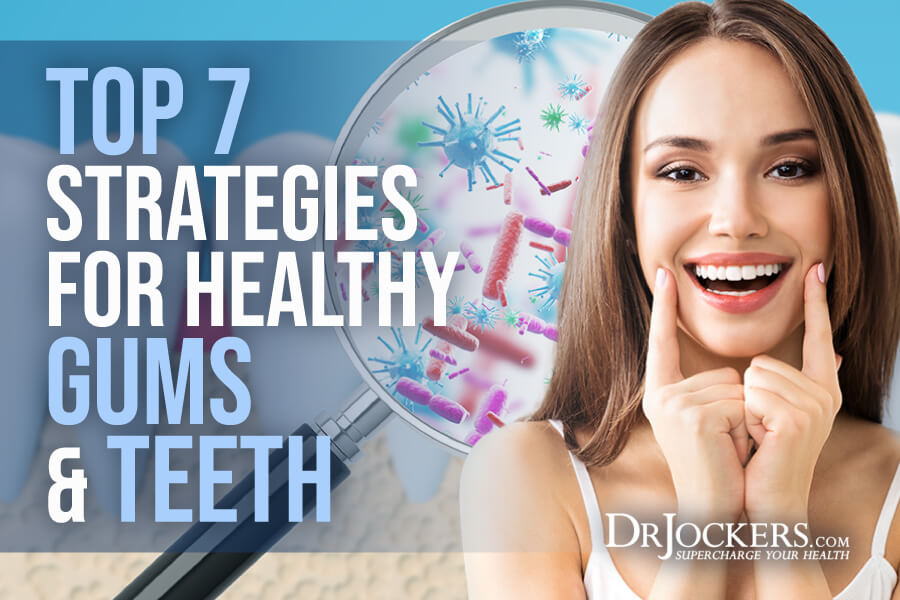 Top 7 Strategies for Healthy Gums and Teeth
Top 7 Strategies for Healthy Gums and Teeth
Everyone wants sparkly beautiful teeth. But there is more to teeth than how they look. Healthy gums and teeth are critical for your overall health. Poor oral health can increase your risk of chronic disease, including diabetes and cardiovascular problems.
In this article, you will learn about the most common oral health problems and the link between poor oral health and chronic disease. I will recommend three natural compounds and seven natural support strategies to support healthy gums and teeth
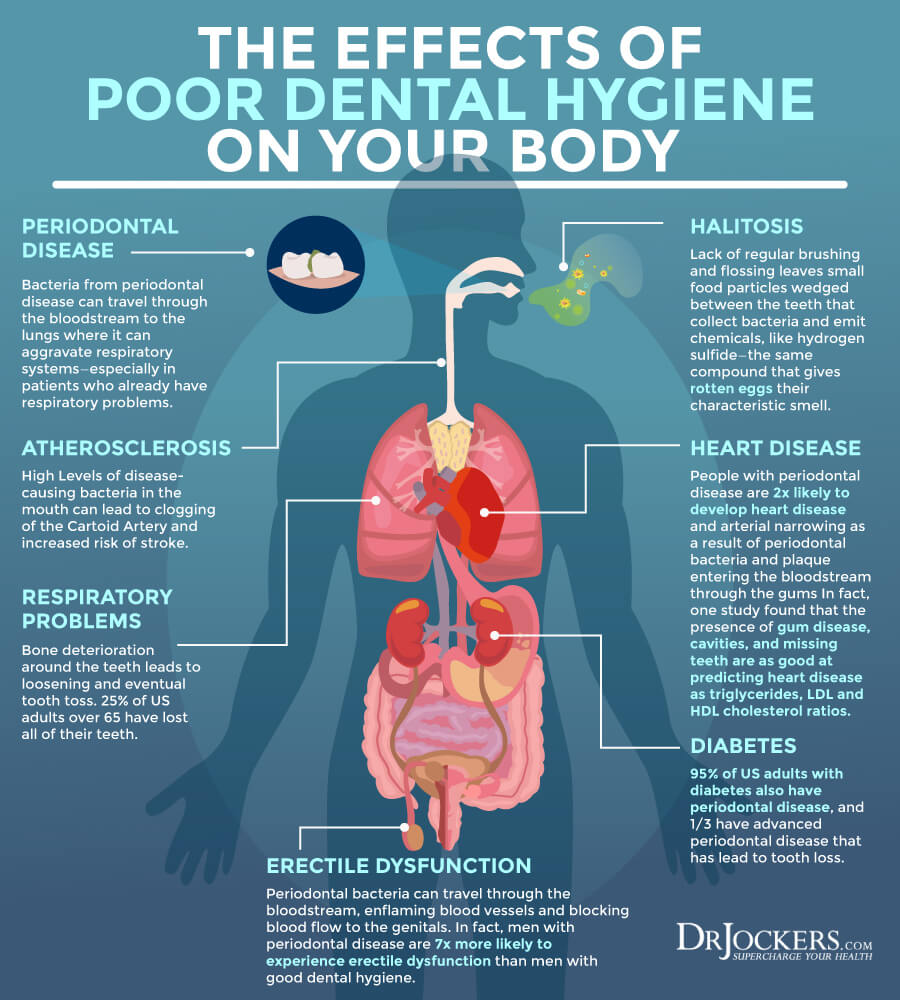
Common Oral Health Problems
There are four common oral health problems, including cavities, gum disease, root canals, and jaw cavitations.
Cavities
Tooth cavities or cavities are also known as tooth decay. They are the most common dental health problem. Cavities are a hole that forms in your tooth. First, they start out small. When left untreated and if you practice poor oral hygiene, they become gradually larger as time goes on.
Early on, cavities don’t tend to cause pain. However, as they become bigger, they may lead to tooth sensitivities, tooth pain, infections, visible holes in your tooth, and discoloration.
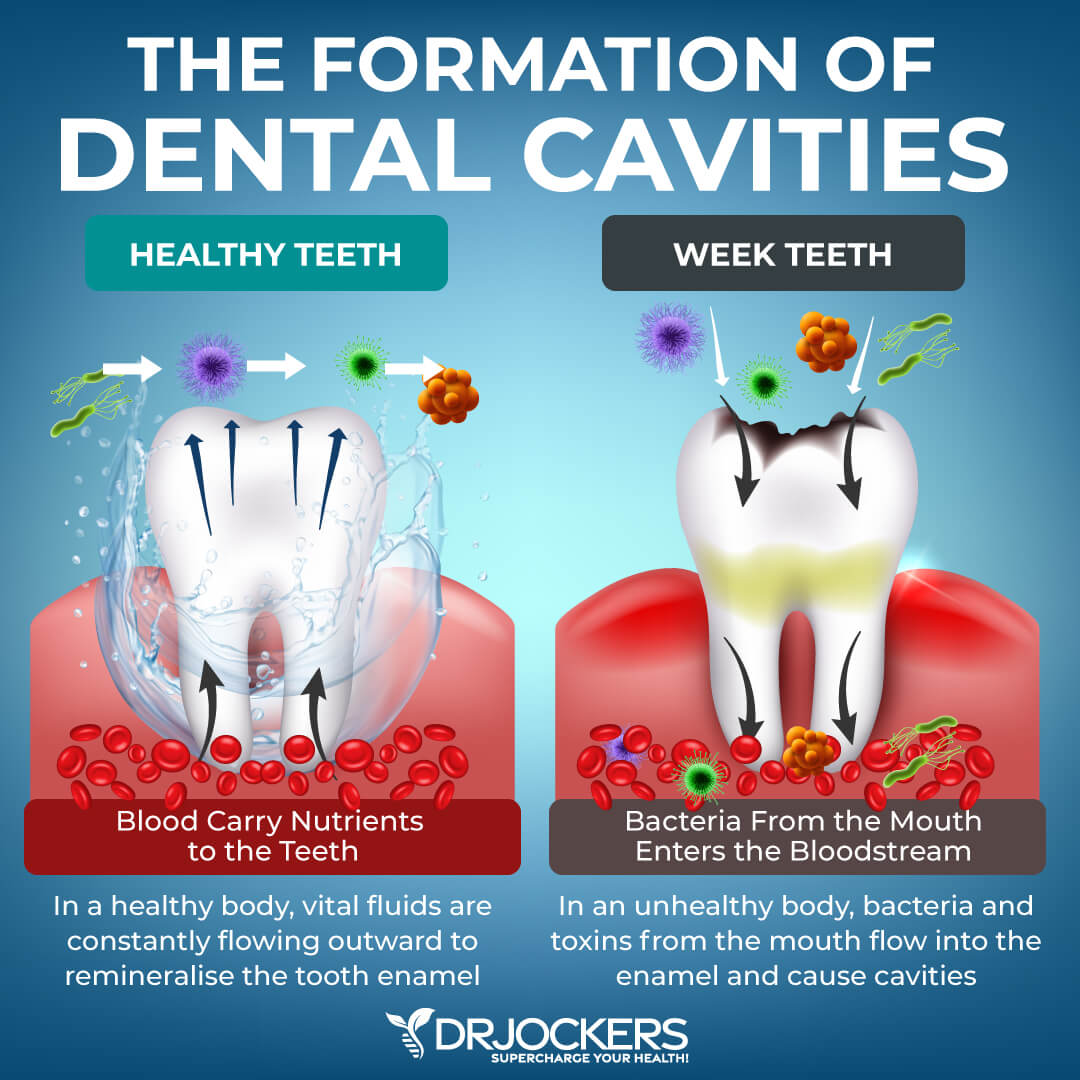
Gum Disease
Gum disease is also known as periodontitis. It’s a serious gum infection. It affects the tissues that hold your teeth in place. It can cause severe damage to the bone that supports your teeth and result in loose teeth or tooth loss. Symptoms may include puffy, red, painful gums that bleed easily when brushing, bad breath, loose teeth, and pain when chewing.
Gum disease usually develops because of poor oral hygiene. It’s largely preventable through brushing and flossing your teeth and regular dental visits.
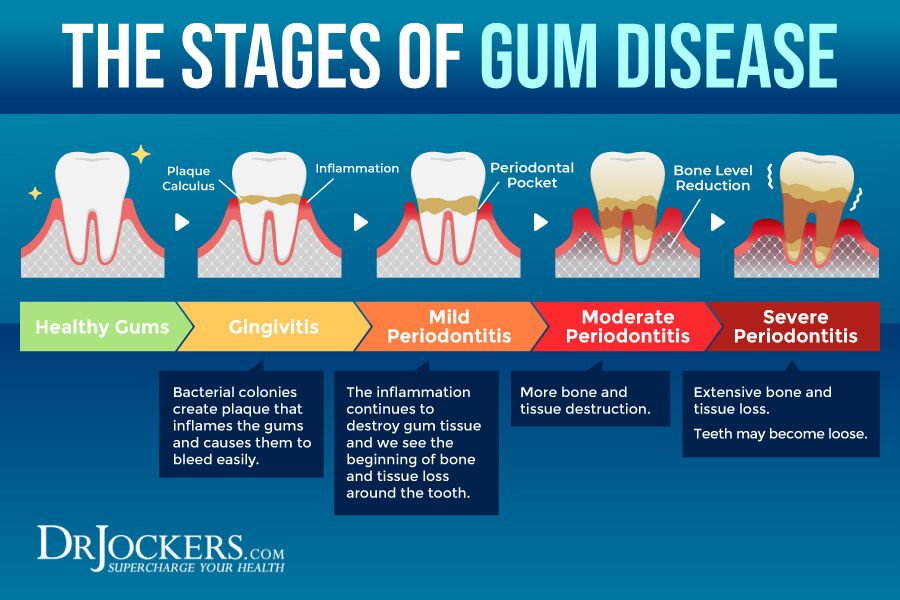
Root Canals
Root canals are commonly recommended by traditional dentists when a cavity is too deep for a regular filling or when there is a deep crack close to or hitting the gum line increasing the risk of further damage, infections, gum disease, tooth erosion, and other inflammatory issues.
The goal of a root canal is to avoid tooth extraction, ‘save’ the natural tooth, and eliminate pain. During a root canal, your dentist removes the soft center of the tooth the pump, which is made up of connective tissues, nerves, and blood vessels. They finish the root canal by capping it with a crown to avoid cracking or other further damage.
Even though root canal treatments have been around for hundreds of years and traditional dentists use them regularly, there are some issues with root canals. There is a risk for human error, there are technological limitations. It’s often not possible to remove all bacteria, which may result in further inflammations, infections, and health issues.
A 2008 study published in the International Endodontic Journal has shown bacteria can reside in teeth that received a root canal even in asymptomatic patients (1). A 2015 study published in Virulence has found that root canals can result in asymptomatic, chronic, and systemic inflammation that can lead to serious health problems (2). Biological dentists do not recommend and avoid root canals. You can learn more about the real problems with root canals by reading this article.

Jaw Cavitations
Jaw cavitations are holes in the bone. You may develop cavitation if a tooth has been extracted but the hole in its place hasn’t been filled or healed properly. When your tooth is extracted, your body naturally fills its place with bone over time. However, if there is any periodontal membrane that remains after the extraction, it may create a spongy space of a hole in your jaw bone instead.
Jaw cavitations can show up on x-rays, however, most traditional dentists don’t find this alarming. The problem is that anaerobic bacteria can easily thrive and toxins can hide inside these jaw cavitations increasing your risk of chronic inflammation, gut health issues, chronic pain, and chronic fatigue.
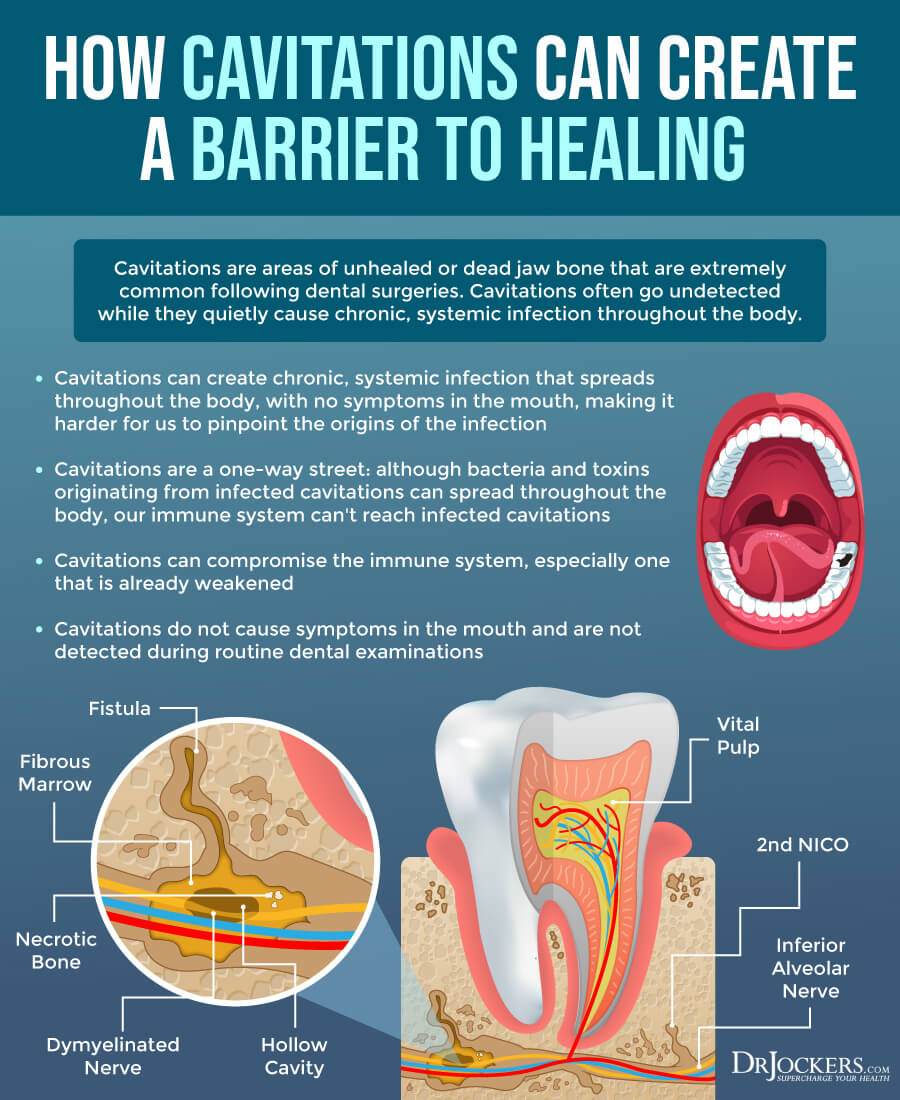
Link Between Oral Health Problems and Chronic Disease
A 2010 scientific paper published in Public Health Reports has called oral health problems a silent epidemic (3). It has drawn a connection between good oral health and overall health, and poor oral health and chronic disease.
A 2019 review published in Preventing Chronic Disease, Public Health Research, Practice, and Policy has also found a correlation between oral health problems and chronic disease (4). Researchers looked at 1,249 systematic reviews including 32 qualitative syntheses. They found a correlation between poor dental health and the increased risk of type 2 diabetes and cardiovascular disease.
Chronic diseases can also increase the risk of oral health issues. Cancer patients often experience dry mouth, sensitive gum, and jaw pain as a side effect of their treatment and dental problems as a result of decreased immunity. Osteoporosis may increase the risk of weak and brittle teeth. Certain autoimmune diseases, such as lupus, may increase the risk of gum disease. Eating disorders can result in the erosion of the enamel due to regular exposure to stomach acid during vomiting.
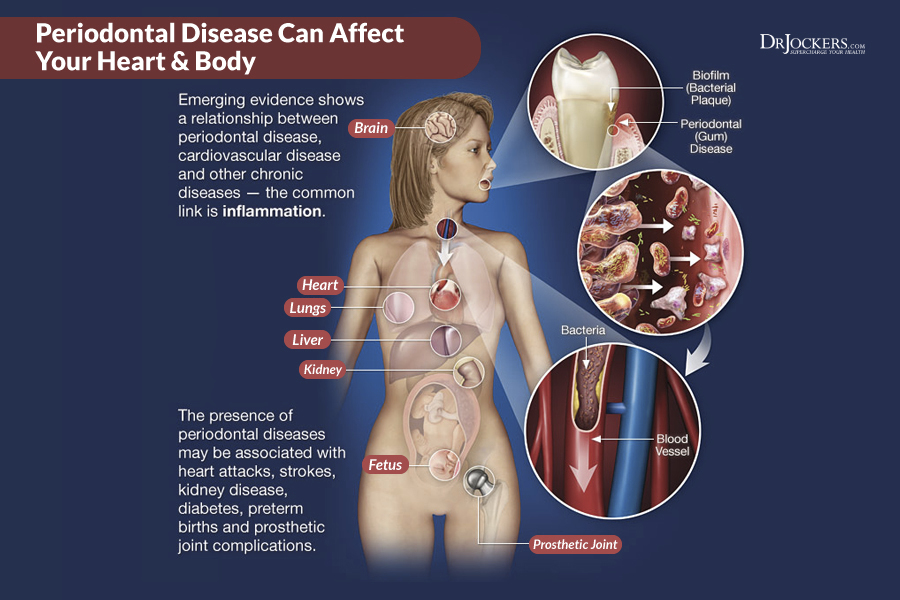
Compounds That Support Healthy Gums and Teeth
If you want to support healthy gums and teeth naturally, there are a few compounds that can help with that.
Baking Soda:
Baking soda or sodium bicarbonate (NaHCO3) is a natural substance used for a number of different household tasks such as baking and cleaning. Baking soda has also been shown to reduce bacterial plaques in our mouth and prevent cavities.
A study done in 2017 showed that when you rinse your mouth with a baking soda and water solution, the pH in your mouth increases, making it less acidic. As a result, using baking soda as a toothpaste may make it harder for cavity-causing bacteria to multiply in your mouth (5).
Baking soda is also a mild abrasive and has the ability to reduce or eliminate stains on teeth to make the appearance of your teeth whiter and shinier (6). A very inexpensive and effective toothpaste can be made with baking soda and hydrogen peroxide.
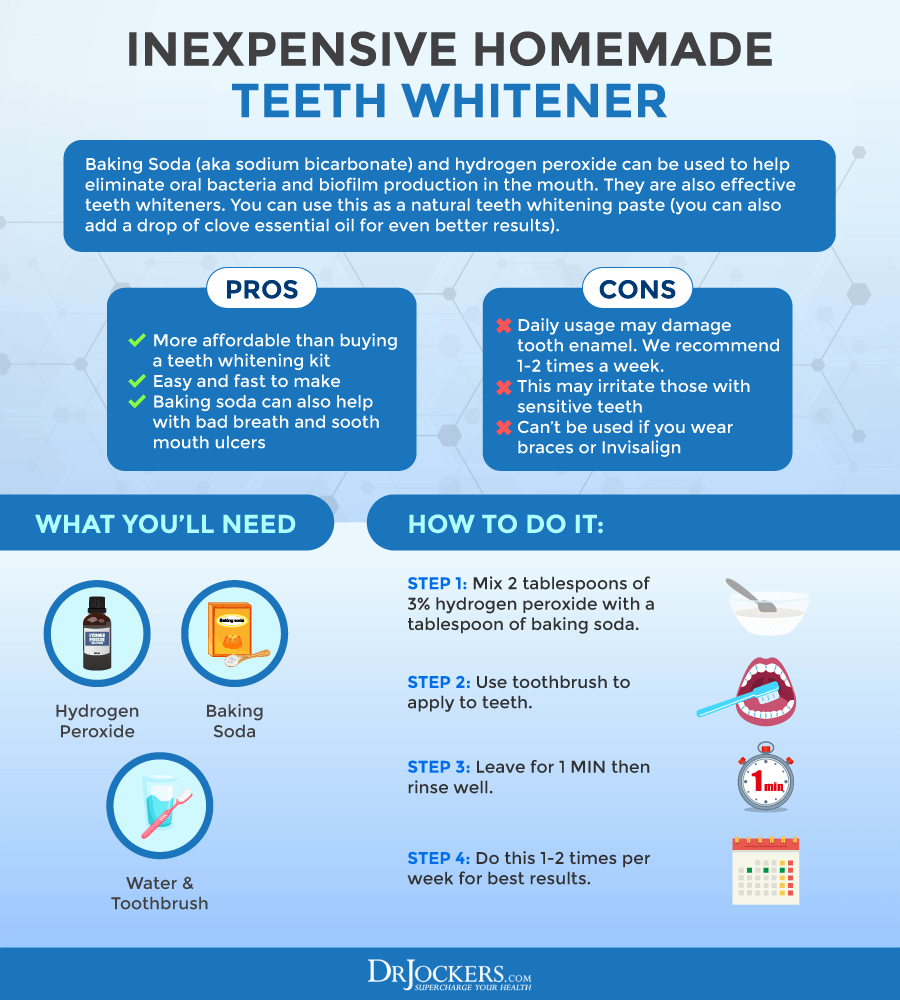
Hydrogen Peroxide:
The FDA has approved the use of hydrogen peroxide (H2O2) as a temporary oral debriding agent and oral wound cleanser. Hydrogen peroxide can penetrate through the slime barrier that protects biofilm and destroys bacterial cell walls. It releases oxygen and creates an environment unfit for anaerobic bacteria to survive (7, 8).
Bacteria that are susceptible to hydrogen peroxide by itself or in combination with baking soda include Actinobacillus actinomycetemcomitans, Haemophilus aphrophilus, Eikenella corrodens, Capnocytophaga gingivalis, Mycoplasma salivarium, Actinomyces naeslundii, Actinomyces viscosus, Streptococcus salivarius, and Streptococcus mutans.
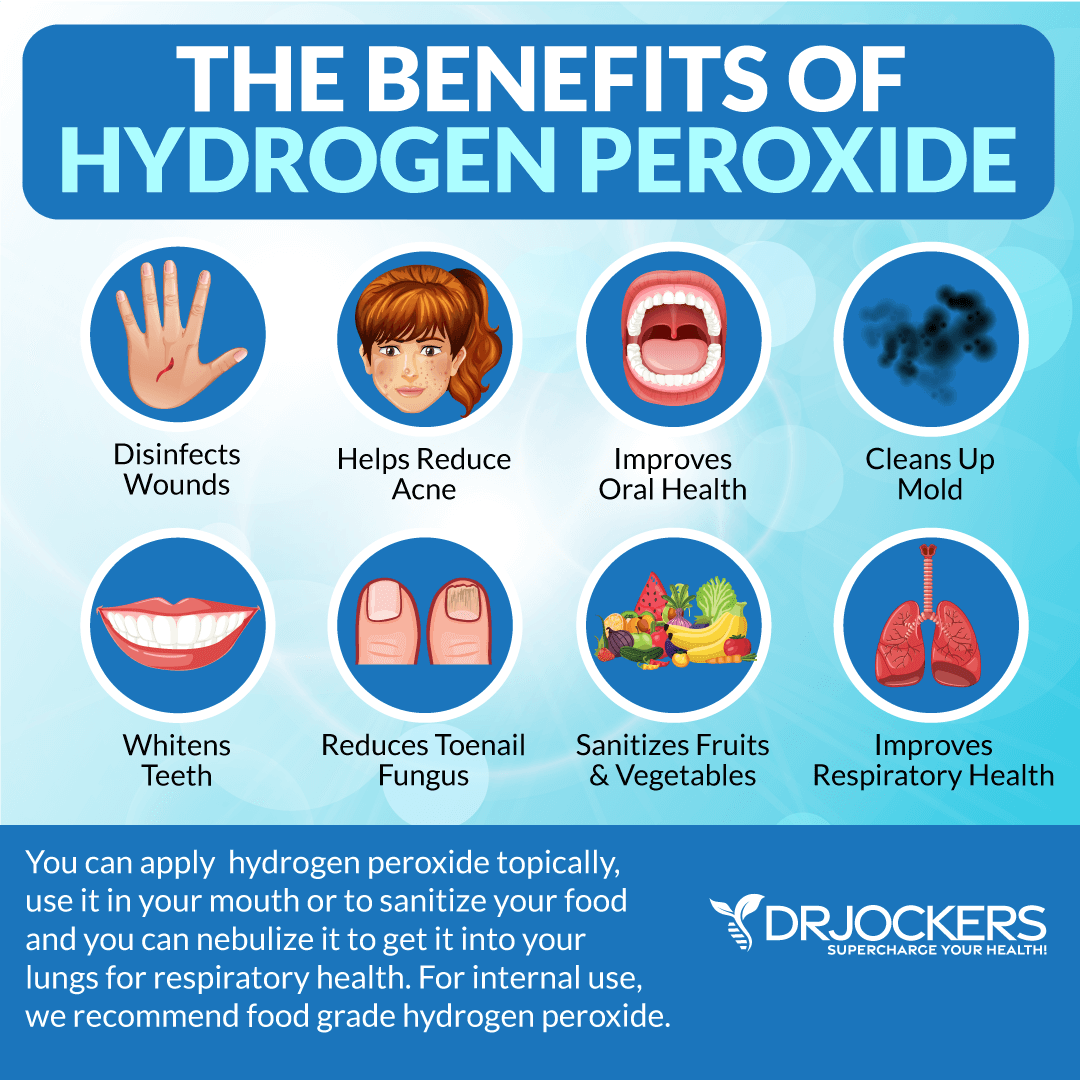
Fulvic Acids
Fulvic acid is a compound that is naturally found in ancient soil or humus. They are bioactive carbon compounds that are abundant in trace and macro minerals, vitamins, organic acids, and amino acids. It allows your cells to absorb and use nutrients more efficiently. It helps proper mineral absorption, detoxification, immune health, and anti-aging.
Consequently, it helps to detoxify your mouth, remove harmful bacteria, and remineralize your teeth. Fulvic acid also supports tissue repair and healing. According to a 2014 presentation at the IUPUI Research Day, fulvic acid can reduce oral bacteria and decrease the risk of cavities and the growth of cancerous oral cells (9).
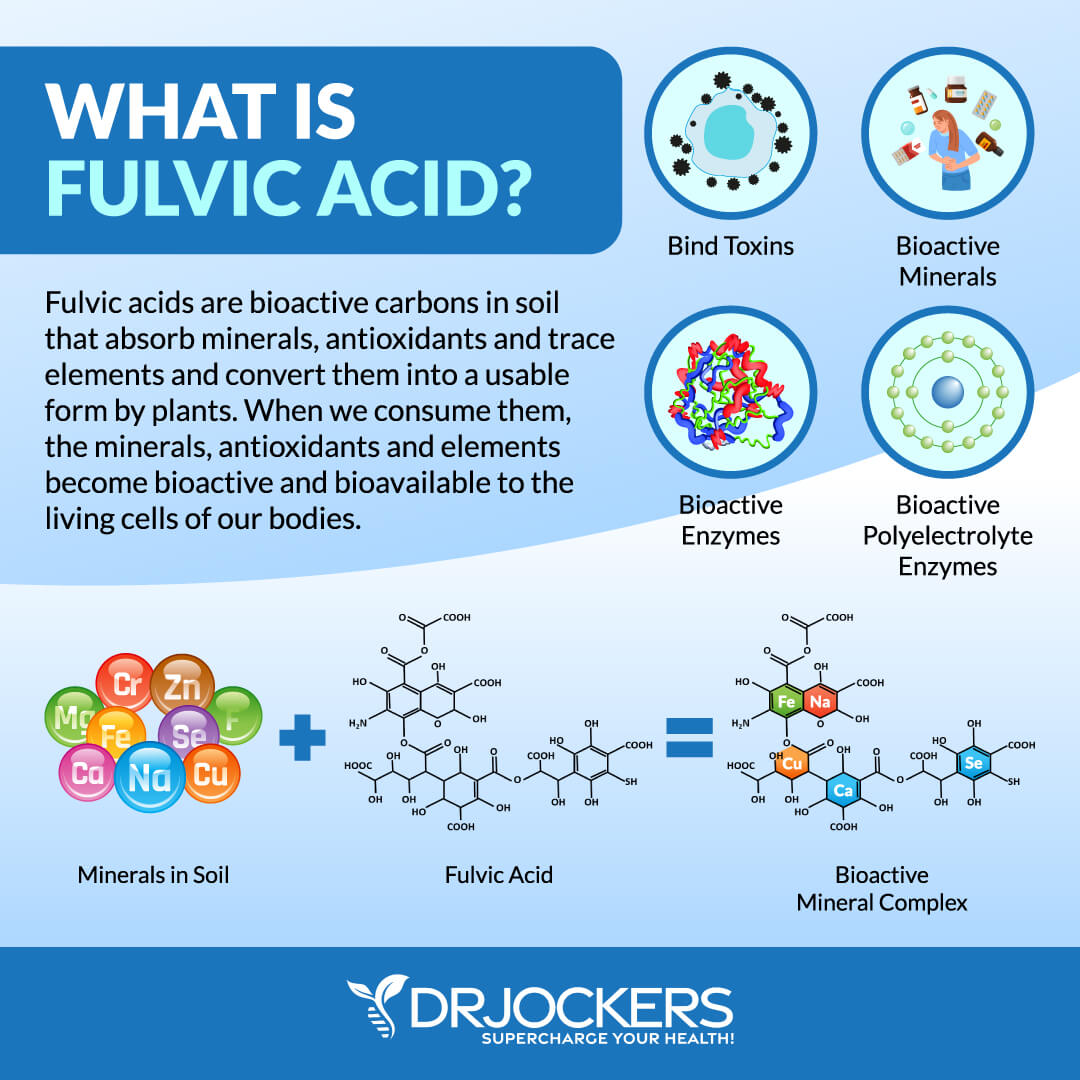
Key Essential Oils
A 2014 study published in the Journal of International Oral Health has found that essential oils can offer oral health benefits in dentistry by supporting hygiene, reducing bacterial overgrowth, supporting wound healing, and reducing anxiety during dentist visits (10). There are five essential oils I particularly recommend, including peppermint, cinnamon, tea tree, clove, and anise.:
- Peppermint essential oil comes from peppermint leaves and can reduce inflammation and the risk of gingivitis.
- Cinnamon essential oil is derived from the bark of the Cinnamon tree and is used for its anti-bacterial properties to prevent cavities.
- Tea tree oil is derived from the leaves of the tea tree plant and is used for its anti-inflammatory, anti-bacterial, anti-viral, and anti-fungal benefits to reduce plaques and gingivitis.
- Clove essential oil is derived from the close evergreen tree and may help to reduce bacterial overgrowth and numb the gums to reduce gum disease and pain.
- Anise essential oil comes from the anise plant’s fruit and is used for its anti-bacterial, anti-septic, and anti-fungal properties.
These essential oils can be found in natural toothpaste, dental floss, and in combination with carrier oils for oil pulling.

Nourishing Clays and Activated Charcoal
Nourishing clays, such as bentonite and kaolin clary, and activated charcoal can also support your oral health. Using clays may support detoxification. They may help to remineralize your teeth with the help of magnesium, potassium, calcium, and silica. They may also help to whiten and polish your teeth.
Activated charcoal is a fine-grained black powder. It’s made from coconut shells, slowly burned wood, olive pits, peat, and other natural substances. It is commonly used to remove plaques, reduce toxins, and whiten teeth in natural dental care.

Top 7 Strategies to Support Healthy Gums and Teeth
Dental care is clearly important, not only for your dental but also for your overall health. Here are the top 7 strategies I recommend to support healthy gums and teeth.
Salt Rinse
Salt eliminates microbes and makes the pH of the mouth alkaline, creating a neutral environment for brushing. A salt rinse is easy and a great strategy after a meal when it is less than ideal to brush your teeth. It is especially good after you have citrus, vinegar or something else that is a strong acid so you can neutralize it right away and prevent the acid from degrading your teeth.
To do this, simply get a Mason jar with a tightly fitting lid and mix one teaspoon of salt and eight ounces of hot filtered water. The hot water works to activate and dissolve the salt into a brine. Once the salt is dissolved, pour a small glass of the mixture, swish for 30 seconds and spit. You can also add a drop of an essential oil if you want as well.

Brush Your Teeth
Brushing your teeth two to three times a day is critical for healthy gums and teeth. However, I advise against conventional toothpaste. Most toothpaste is made with the use of fluoride. Fluoride can increase the risk of cognitive problems, cancer, hormonal issues, and diabetes.
A 1993 study published in the Journal of the International Society of Fluoride have both connected fluoride exposure to an increased risk of cancer (11). A 2015 study published in the Journal of Diabetes Research has found that low-level fluoride in water may help insulin sensitivity suggesting that higher levels may increase the risk of insulin resistance and diabetes (12).
Besides fluoride, conventional toothpaste may be high in other harmful chemicals. Instead, I recommend clay-based toothpaste with minerals and essential oils that help to remineralize your teeth while gently cleaning away bacteria and toxins and reducing the risk of dental problems.
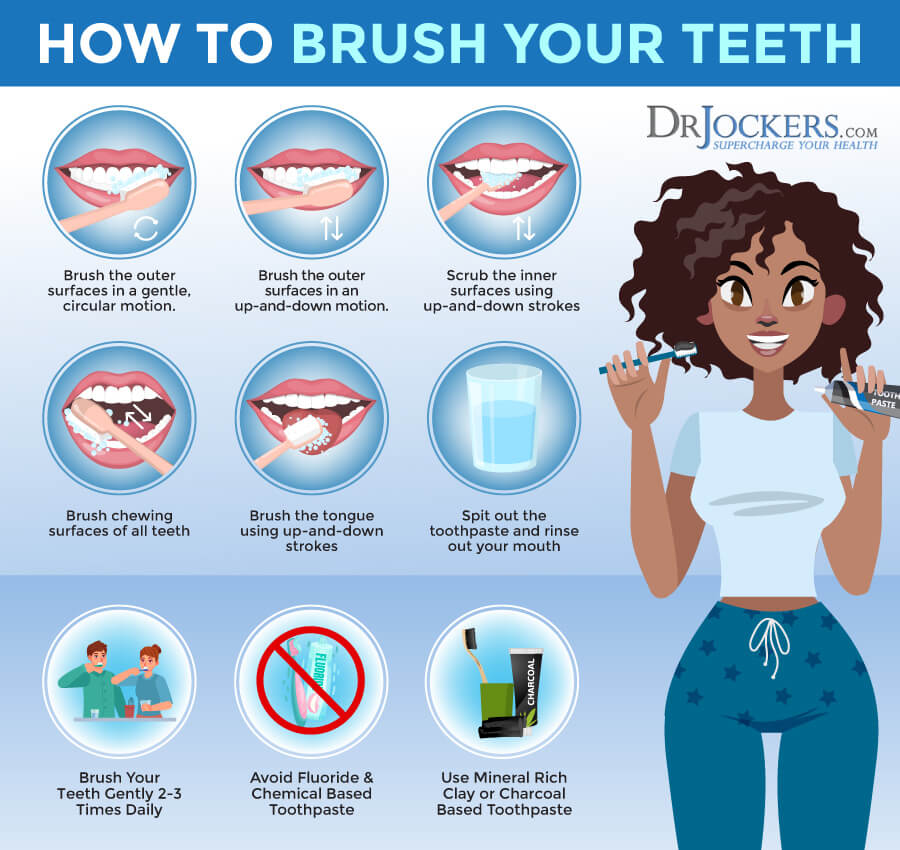
Floss Daily
Flossing daily is a non-negotiable dental hygiene practice. It helps to remove food stuck between your teeth and bacteria. It helps to reduce plaques, cavities, gum disease, and bad breath. Just like conventional toothpaste, conventional dental floss is also full of chemicals that may harm your health.
Instead, I recommend using floss with essential oils and fulvic acid to remove any food particles, bacteria, and toxins and naturally protect your teeth. Be gentle with flossing and don’t over irritate your gums. For detailed instructions on how to floss follow the image below or read this article.
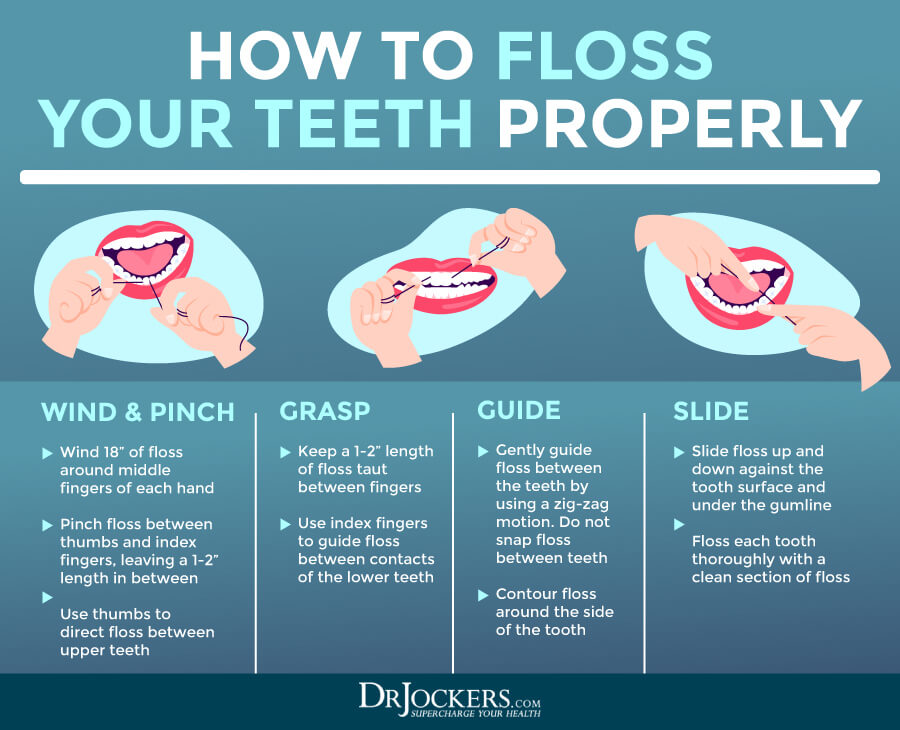
Oil Pulling
Oil pulling is an effective natural strategy for non-fluoride holistic oral care. Oil pulling with coconut oil helps ‘pull’ out toxins from your oral cavity. It helps to decrease inflammation, bad microbes, and the risk of infections. I recommend oil pulling with coconut oil every morning upon waking before brushing your teeth.
- Squish a tablespoon of coconut oil in your mouth for about 20 minutes.
- For the best results, you may also combine it with sesame seed, black cumin, and essential oils for antimicrobial benefits.
- Once you’re done, spit it out and brush your teeth carefully.
- Since you are brushing away toxins, I recommend using a different toothbrush after oil pulling than other times of the day.

Tongue Cleaner
Tongue cleaners or tongue scrapers are small rounded tools made out of metal or plastic that help to scrape away toxins, reduce the risk of dental health issues, improve taste, and eliminate bad breath. According to a 2005 study published in Odonto-Stomatology Tropicale, tongue cleaning can remove bad bacteria from your mouth and reduce the risk of periodontal disease (13).
I recommend cleaning your tongue every morning after brushing your teeth. I recommend getting a good surgical-grade stainless steel tongue scraper. To scrape your tongue, follow these steps:
- Open your mouth and stick your tongue out in front of the mirror.
- Place the rounded end of the tongue scraper at the back of your tongue. If you feel like gagging, you may start around the middle and gradually move farther each time.
- Slowly and gently move the tongue scraper forward until the tip of your tongue.
- Remove any debris after each scrape with water or a washcloth.
- Repeat until you feel like you cleaned the entire surface of your tongue. Two scrapes are usually enough, however, you may find that you need more.
- Wash your tongue scraper carefully with warm water and soap. Dry and store it in a dry area until the next morning.

Baking Soda and Apple Cider Vinegar
A great strategy for getting a deep oral cleaning is with the “Keyes Technique,” of combining baking soda and apple cider vinegar to create a strong chemical reaction that effectively eliminates plaque and resets the oral microbiome. This strategy was popularized by Dr Paul Keyes, who is a former clinical investigator at the National Institute of Dental Research.
To do this, you simply coat your teeth and tongue with baking soda using a toothbrush and then put 1 tsp of hydrogen peroxide or undiluted apple cider vinegar into your mouth. The combination of the alkaline bicarbonate from the baking soda with the hydrogen ions from the acidic hydrogen peroxide or vinegar create a foaming effect in your mouth.
While your mouth is full of this foam, you brush your teeth, gums and tongue. This technique helps get rid of hard to remove bacterial biofilms in the teeth, gums and tongue and helps to whiten the teeth and eliminate bad breath. You can do this once or twice a week for great results.
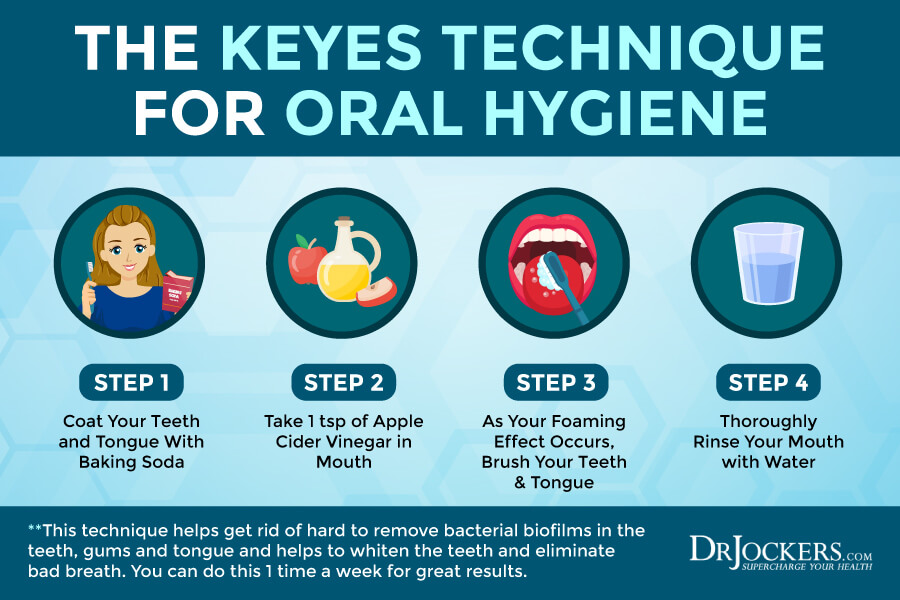
Nutrient and Mineral Support
Brushing, flossing, and oil pulling are not enough. Your diet matters a lot. According to a 2012 study published in the Journal of Biomedicine and Biotechnology, there is an important connection between diet and good oral health (14).
A diet high in sugar and processed foods can result in dental and oral health problems. Eating a diet low in trace minerals can lead to the demineralization of your teeth causing weak, brittle, and problematic teeth.
I recommend that you follow an anti-inflammatory diet low in sugar, free from processed foods, and rich in trace minerals. Since bioactive carbons such as fulvic acids are high in trace minerals, help to remineralize your teeth, reduce bad bacteria, support healthy gums, and lower the risk of dental issues, I recommend using that in your dental care as well (9).
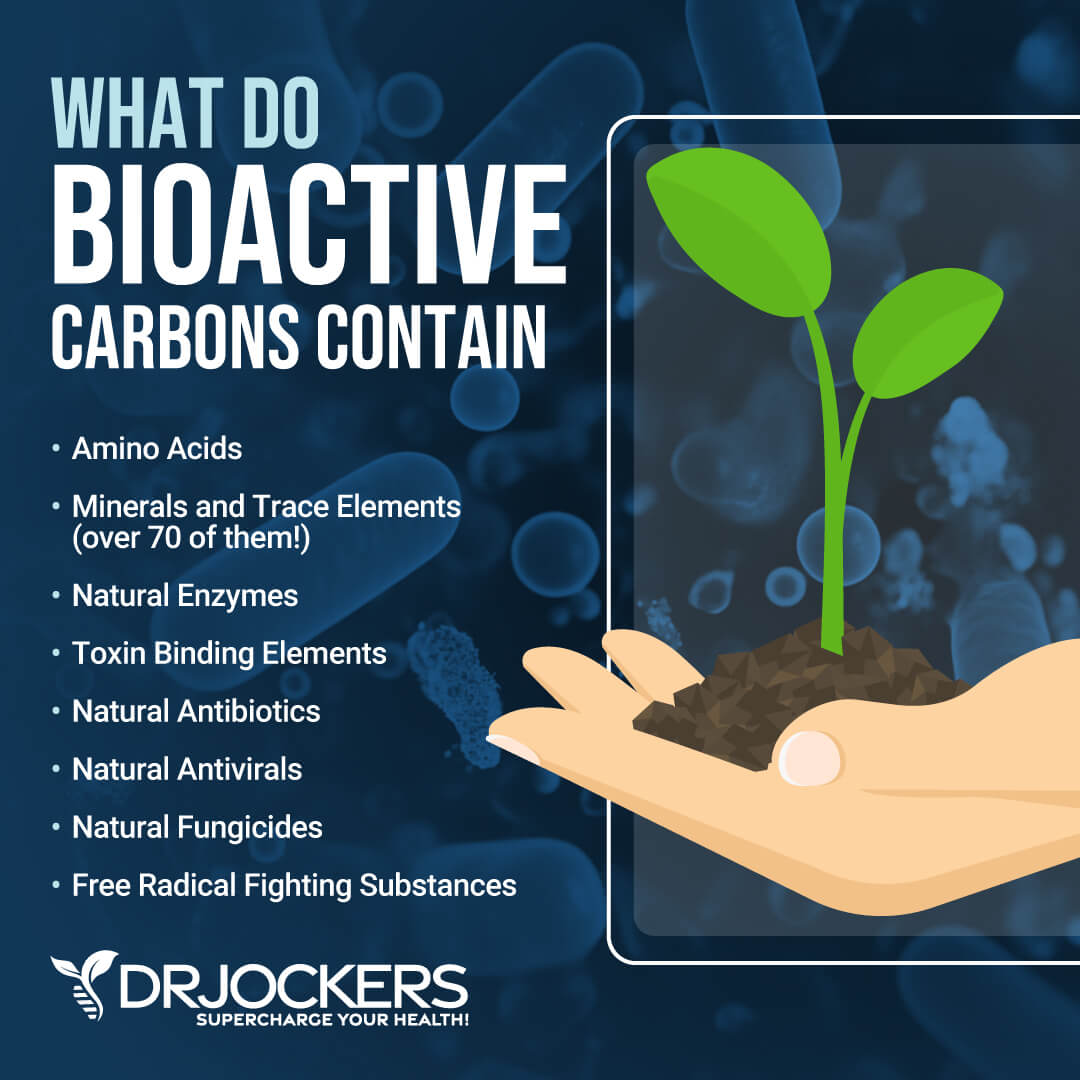
Akamai Kit
For healthy gums and teeth and at-home, natural, and holistic dental care, I recommend the Akamai Kit. This kit has everything you need:
- Mineral Toothpowder – Supercharged with nourishing clays, trace minerals & fulvic acid. No plastic + refillable system.
- Infused Black Floss – Clinically proven to remove up to 40% more plaque than typical flosses.
- Bamboo Toothbrushes – Effectively & gently cleans under the gumline to avoid gum loss with an innovative design
- Fulvic Mineral Complex – Helps feed teeth from within and aids in whole-body health.
- Oil Pulling Mouthwash – Certified organic, cold-pressed, unrefined oils help nourish & detoxify your mouth and gums.
- Tongue Cleaner – Simple, powerful stainless steel tool that helps get rid of bad breath.
Plus Akamai is both a B Corporation and 1% for The Planet Member. Certified B Corporations are a new kind of corporation that uses the power of business to improve environmental issues for cleaner air and water. The 1% for The Planet is an organization of companies that contribute at least one percent of their annual sales to environmental causes.
To date, this has totaled $175 million. Through this initiative, Akamai supports like-minded, high-impact nonprofits including the Environmental Working Group and The Surfrider Foundation.
Bonus Strategy
I also recommend oral Irrigation with a Hydro Floss Oral Irrigator for healthy gums and teeth. This product is a highly effective magnetized water oral irrigation device.
It helps to clean your teeth sparkly clean and get rid of hard-to-reach bacterial colonies. According to a 1998 study published in the Journal of Clinical Periodontology, using hydro floss is effective for plaques, gingivitis, and calculus (15).
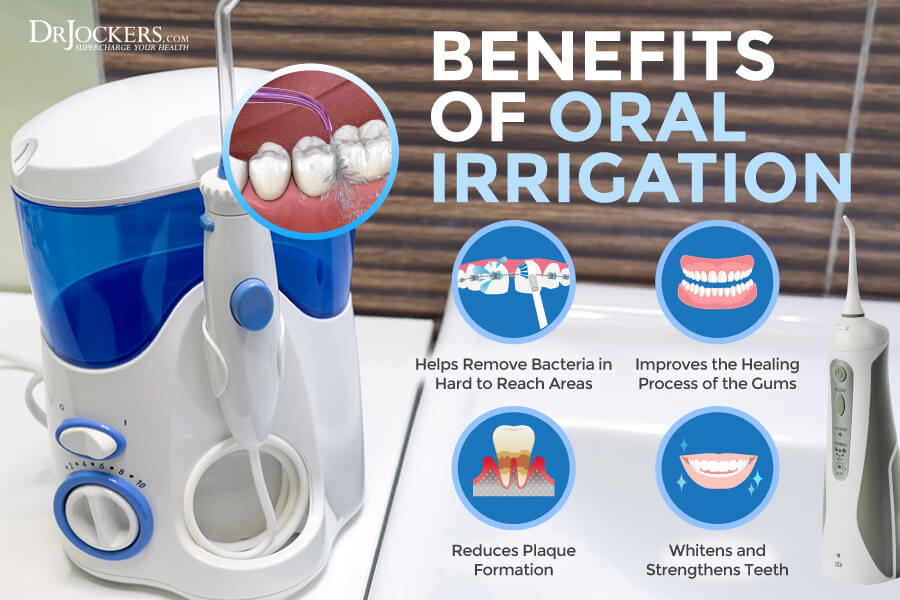
Final Thoughts
Poor oral health can increase your risk for chronic disease. You want to take care of your teeth to protect your entire body. I recommend that you follow my five natural support strategies to support healthy gums and teeth.
If you want to work with a functional health coach, I recommend this article with tips on how to find a great coach. Our website offers long-distance functional health coaching programs with our world-class team of health coaches. For further support with your health and other goals, just reach out—our fantastic coaches are here to support your journey.
Inflammation Crushing Ebundle
The Inflammation Crushing Ebundle is designed to help you improve your brain, liver, immune system and discover the healing strategies, foods and recipes to burn fat, reduce inflammation and Thrive in Life!
As a doctor of natural medicine, I have spent the past 20 years studying the best healing strategies and worked with hundreds of coaching clients, helping them overcome chronic health conditions and optimize their overall health.
In our Inflammation Crushing Ebundle, I have put together my very best strategies to reduce inflammation and optimize your healing potential. Take a look at what you will get inside these valuable guides below!





Thank you so much for all this information. I have had several root canals and one has a small abscess. I have reached out to a biological dentist in Houston but it is quite expensive for a senior. However, I guess I will see her and sacrifice the money as I am 72 and would like to live as healthy as possible until the Lord takes me home.
I also watched Jonathan Landsman symposiums.
Y’all are a blessing.
Glad to hear that! Blessings to you!
Dr. Jockers,
Your article is one of the most informative articles on oral health that I have seen. I have always been a “nut” about my oral health for over 60 years. You answered some of my questions that still lingered: 1) how often to use baking soda and if it is harmful for the enamel; 2) reinforced what I learned over a lifetime. Back in the day, after I had just gotten my second molars & bicuspids and it was when dental schools thought it would be a brilliant idea to fill all those crevice lines on top of each molar so they wouldn’t develop in to cavities. At the time, they used amalgam, so 12 teeth were filled with amalgam. Fifty years later I had those amalgams removed. I have gone to a biologic dentist ever since and am a fanatic about cleaning my teeth. I use floss, toothbrush, wooden toothpick, and occasionally baking soda & hydrogen peroxide. Thank you so much for sharing your knowledge.